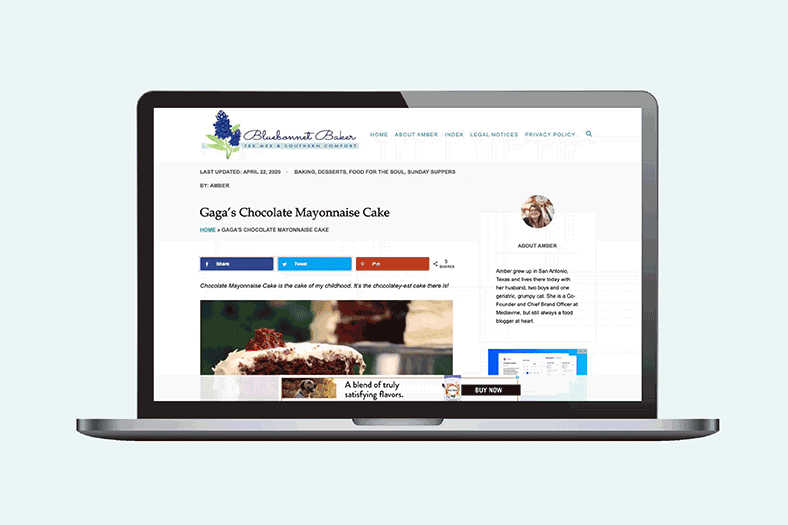Desktop Interstitial Ads Are Live: Should You Enable Them?


As you know, Mediavine recently brought back the mobile interstitial for a second act after its unspectacular debut a few years ago.
Now, as promised, we’ve launched its desktop counterpart in all its glory (and scary user experiences, which we’ll touch on shortly).
Like the mobile interstitial, but for desktop devices, this is a full-screen display ad that takes over the screen between pageviews.
Why would anyone throw a full-screen ad in front of their audience?
As Mediavine Ad Management clients know, they pay very well.
You can’t get much more viewable or engaging than a full-screen ad unit. By definition, interstitial ads are highly viewable and see terrific user engagement. Advertisers know it and will pay top dollar for these units.
Crazy as it seems to those of us who can remember when interstitials were anathema to Google, they are now a viable option.
Some of you may remember that we retired interstitials the first time due to Google’s mobile content accessibility signal.
Now in 2021 they’re back and conforming to Google Search and Coalition for Better Ads standards. How do we know?
As we told you last year, during the Google Mobile Web Interstitial beta, Google Ad Manager renders the unit to “match Google Search standards.”
Long story short: Because the new mobile (and now desktop) interstitials run between pageviews, not when a user first arrives, they won’t hurt your search results.
Like the mobile version, these desktop interstitial units will appear only after the second click, with Mediavine running its ad auction alongside Google Ad Exchange and Google Ad Manager rendering the creative.
From an SEO standpoint, you are good to go.
As with the mobile interstitials, the ads can be closed immediately, with no countdown or set time that you have to wait out.
As soon as a reader clicks a link to advance to the second pageview, ads are instantly ready to be shown.
They also have a consistent and easy-to-find close button. Hard-to-find close buttons defeat the point of even having a close button.
You can see a sample one running here:

As we mentioned above, the reason interstitials exist is because they produce high viewability and click-through rates (CTRs) that drive revenue accordingly.
We’ve seen a 9.18% increase in desktop RPM from running these interstitials during initial testing — potentially significant but not without caveats.
Since these ads only run between pageviews and are frequency capped (so a given user can only see them a certain number of times), not everyone will see them.
A desktop user will only see an interstitial upon clicking on an external or internal link on your site, not when they first arrive or scroll around.
Also worth remembering: As with any site joining Mediavine, or any new ad unit we enable, there is a ramp up period or learning curve for advertisers.
Optimal performance takes time, in other words.
Furthermore, with very few exceptions, how much desktop traffic a website actually has probably ranges from almost none to… not very much.
Increasing your RPM for those desktop users won’t make you much extra money if you only have 12 of them, and you’ll diminish their user experience to boot.
Which brings us to our final, most significant caveat:
Honestly?
To quote our attorney, “it depends.”
This is ultimately your decision as a publisher. From a pure monetization standpoint, there may be an argument that it’s worth it.
For those of you with desktop traffic, the potential of up to 9.18% RPM lift could be material. Of course, you’re selling your soul a bit for it.
The user experience of these ads is… not the best.
Of course, all ad solutions must strike a balance of user experience and revenue, and based on the publisher’s goals, this can be subjective.
But the desktop interstitial UX is in its own league.
Use caution before throwing up full-screen ads that your readers have to “X” out of. As a reader, you wouldn’t like that either.
Passing the Coalition for Better Ads and Google Search standards doesn’t mean they should pass your personal standards.
We wrote this article because it’s an option that’s available to you that we feel you should know about and so that you can understand the pros and cons of running these ads.
Not because we necessarily think everyone should use it.
Our recommendation is to think long and hard about whether it’s truly worthwhile.
Should you choose to switch these on, desktop interstitials are available to all Mediavine publishers, via opt-in in the Dashboard.
You can access them by logging in, going to Ad Settings > Optional Ad Units.
Stay up to date with the latest from Mediavine
As the digital advertising landscape evolves, the need for effective data management and compliance has never been more critical. As part of our commitment to providing exceptional solutions for our …
Welcome to the much-anticipated release of the fifth-annual edition of “The Best eCPM Days of the Year” calendar. Each year, we analyze historical trends to provide publishers with a graphical …
“Let’s talk about politics.” We know. This is a phrase absolutely no one wants to hear uttered around the dinner table or backyard barbecue these days. But hear us out. …